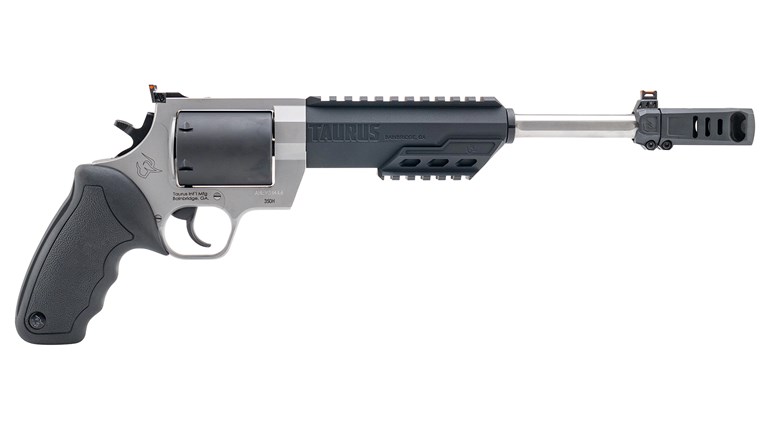
Action pistol shooters need accurate, reliable ammo that also meets minimum “power floors,” and now two new factory cartridges are specially loaded to meet these requirements. Federal’s Gold Medal Action Pistol offerings in 9 mm Luger and .40 S&W feature flat-nose bullets for enhanced steel knockdown, and Federal says accuracy and consistency are improved over the original Gold Medal ammunition.
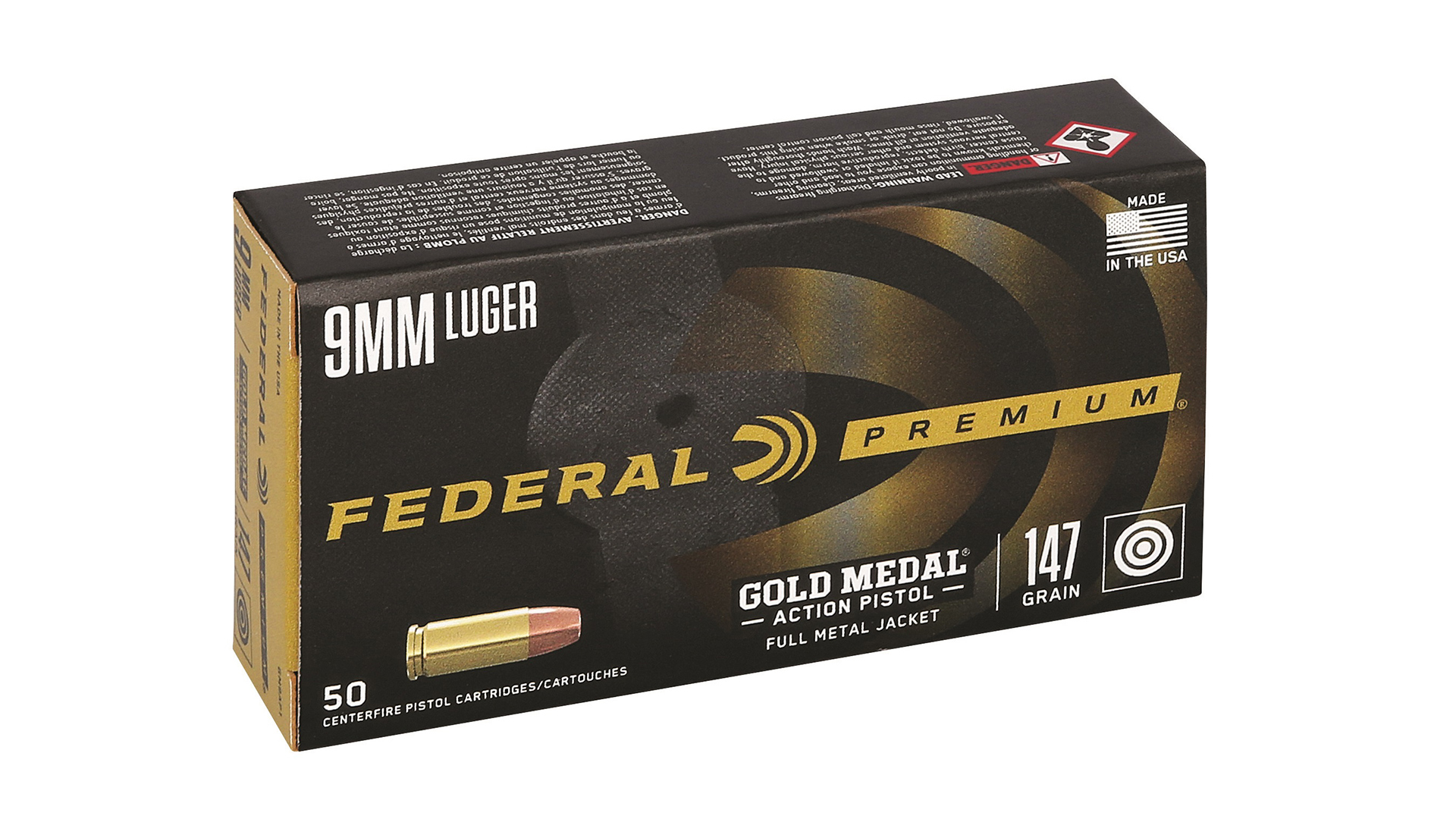
Most action pistol competitions have minimum “power floor” requirements for ammunition. Power floors are figures based on bullet weight and velocity. Power floor compliance is determined by multiplying bullet weight times bullet velocity and then dividing by 1,000; the resulting number—the “power factor”—determines whether or not the ammunition qualifies for competition in that particular niche. Using a 147-grain bullet at 900 f.p.s. as an example, we get 147 x 900 = 132,300. Dividing that result by 1,000 results in a (rounded) power factor of 132. A bullet/cartridge with a power factor of 132 can participate in competition niches with power floors of 132 or less.
Power floors also help ensure a pistol cartridge can knock down reactive steel plates. Each of the action pistol competition organizations have their own rules about power factors. At the lowest end, Steel Challenge doesn’t utilize power factors at all. International Confederation of Revolver Enthusiasts (ICORE) has just one power factor of 120. United States Practical Shooting Association (USPSA) has two power factors, a Minor (125) and Major (165). International Defensive Pistol Association (IDPA) has quite a few power factor minimums because in IDPA action pistol competition, the emphasis is on “defensive.” While many other shooting disciplines may reduce bullet velocities in pursuit of best precision, light target loads are not desirable for a defensive situation, and so IDPA rules include minimum performance parameters for “service ammunition,” ammo that would realistically be chosen for self-defense. IDPA power floors vary depending upon the division in which the handgun is to be competing. For 147-grain bullets, the highest power floor is in the Pistol-Caliber Carbine and PCC10 Specialty divisions, in which the bullet velocity must exceed 918 f.p.s., because the power floor is 135,000 (147 x 919 = 135,093 ÷ 1,000 = 135, rounded). In IDPA, competitors may have their ammunition power factors checked by an official randomly selecting three of their rounds and chronographing the velocities 10 feet from the muzzle, and then weighing another random bullet on a scale, if necessary.
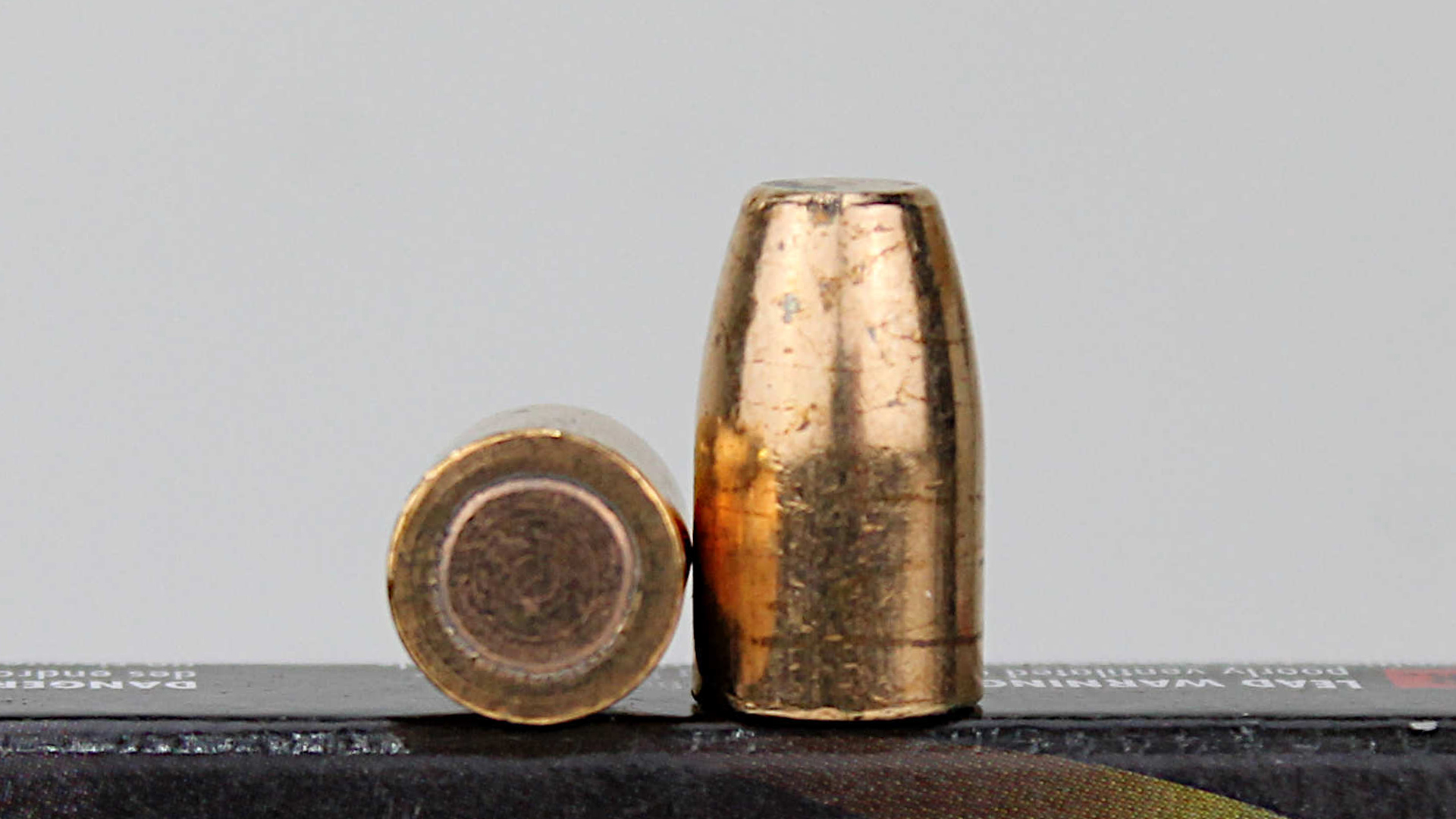
POWER FACTOR MATH
Federal says its new Gold Medal Action Pistol ammunition “is loaded to power factor requirements.” Whose requirements? Does that mean it makes minimum “power floor” across the board? That’s easy enough to determine with a chronograph and fourth grade mathematics. Evaluating Gold Medal Action Pistol 147-grain 9 mm cartridges here, a Doppler radar chronograph showed average velocities of three 10-shot strings make even the highest power floor with power factors of 136.2, 135 and 134.6. That last string appears to have not quite cut the cake, but consider that correctly rounding 134.6 upward actually makes a power factor of 135. Also consider the test barrel used here has a length of four inches; another half-inch would surely bring velocity up a smidgeon. The chronograph also showed single-digit standard deviations and low (for a pistol cartridge) extreme spreads, indicating consistent load components and procedures.
CONSISTENCY CHECK
Consistency of each of the components from cartridge to cartridge is instrumental in creating precision ammunition. Gold Medal Action Pistol 147-grain 9 mm bullets, cases and powder charges all weighed in at better-than-common-ammo consistency. Bullets pulled from 10 cartridges and weighed on a scientific scale with sensitivity to 0.01 (one-hundredth) grain showed a variation of only 0.39 grain between the lightest and heaviest, the lightest weighing 146.54 grains and the heaviest 146.93 grains. Handloaders know that among pistol bullets, less than a half-grain difference in a batch of bullets is pretty good; ordinary “plinking ammo” jacketed bullets can show twice that difference, and sometimes more. Federal’s non-cannelured bullets are tightly crimped into their cases, but pulled bullets showed no distortion from the heavy taper crimp. Primed cases demonstrated good consistency, with only a 1.59 grain split between heaviest and lightest.
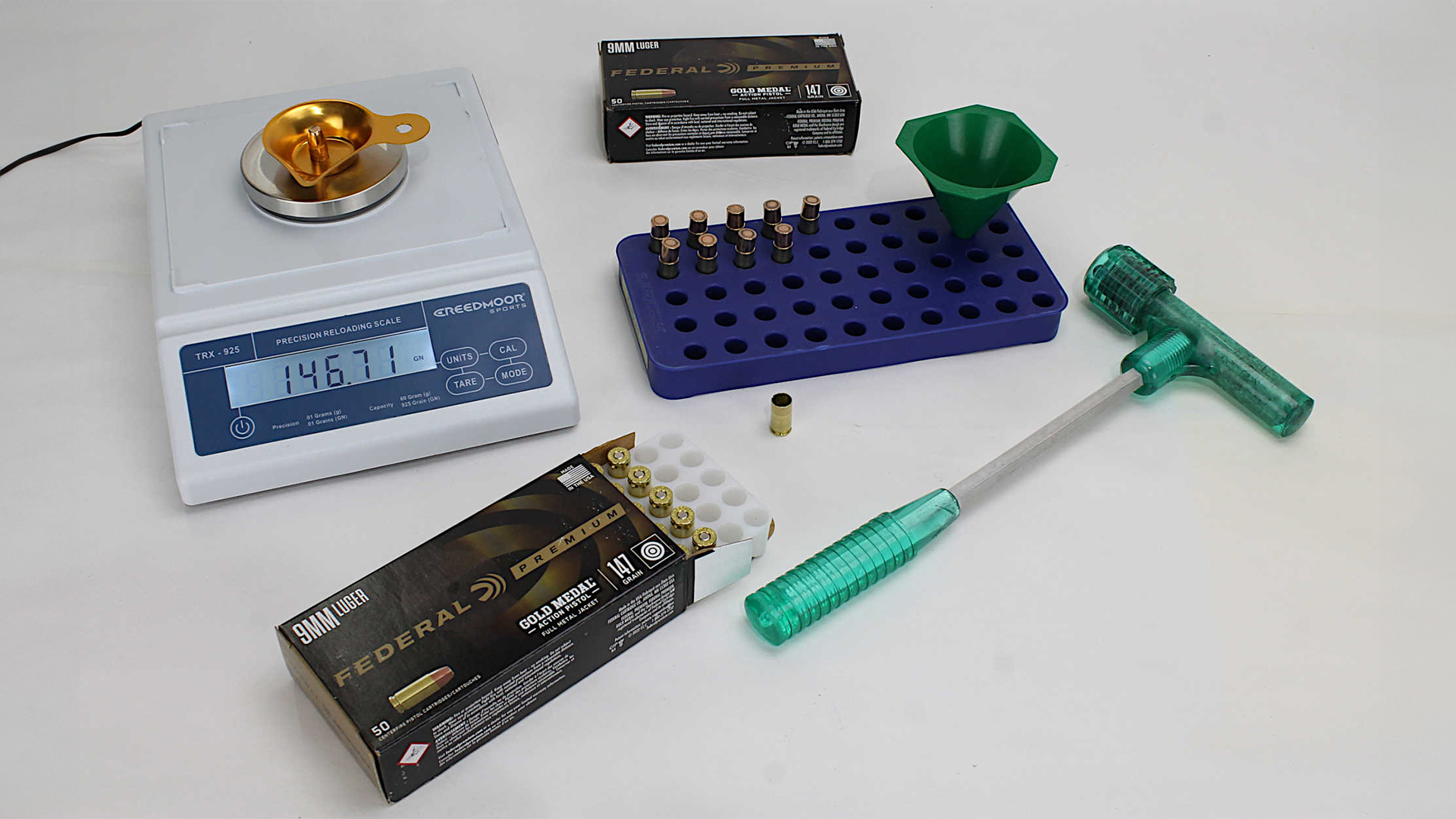
Powder charges, too, were reasonably consistent for mass-produced ammunition, varying only 0.37 grain between lightest and heaviest charge that averaged 3.56 grains in weight. For obvious capitalist reasons, ammo makers don’t like to give away too much specific information on their recipes. Federal refers to the Gold Medal Action Pistol powder as a “specially formulated propellant.” In appearance, the kernels resemble the flat discs of Hodgdon HS-6, though darker in color. Among all my pistol powders, I couldn’t find an exact visual match, so Federal keeps its recipe to itself here.
COMPONENT WEIGHT
Component weight (in grains) of 10 Federal Premium Gold Medal Action Pistol 147-grain 9 mm cartridges.

FLAT-NOSE CONFIDENCE
How does one evaluate whether flat-nose bullets are more consistent than roundnose bullets at knocking down steel? That’s a tough one to demonstrate convincingly (depending upon one’s credulity) without a large sampling under strict controls—say, clanging 1,000 round-nose and flat-nose bullets into identical steel plates with plates and bores firmly fixed at identical angles under identical environmental conditions—but the flat-nose bullets do offer that theoretical confidence. And, many shooters will agree from experience that confidence in one’s gear can be a big factor in any competition. Yet, any experienced pistolero can tell you there’s a trade-off between flat bullet noses dropping steel and still feeding reliably through a semi-automatic pistol; feeding is something we can evaluate.
A BRG 9 Elite 9 mm pistol served as test bed for velocity, function and accuracy evaluation of Federal’s Gold Medal Action Pistol 147-grain 9 mm ammunition. The choice is entirely subjective—I like the pistol’s ergonomics and decided it deserves more shooting—but it’s also practical as an affordable IDPA-eligible pistol. Fired from a sandbag rest at 25 yards, the ammunition is fully capable of grouping on an eight-inch steel plate, and there were no feeding, ejection or cycling problems whatsoever.
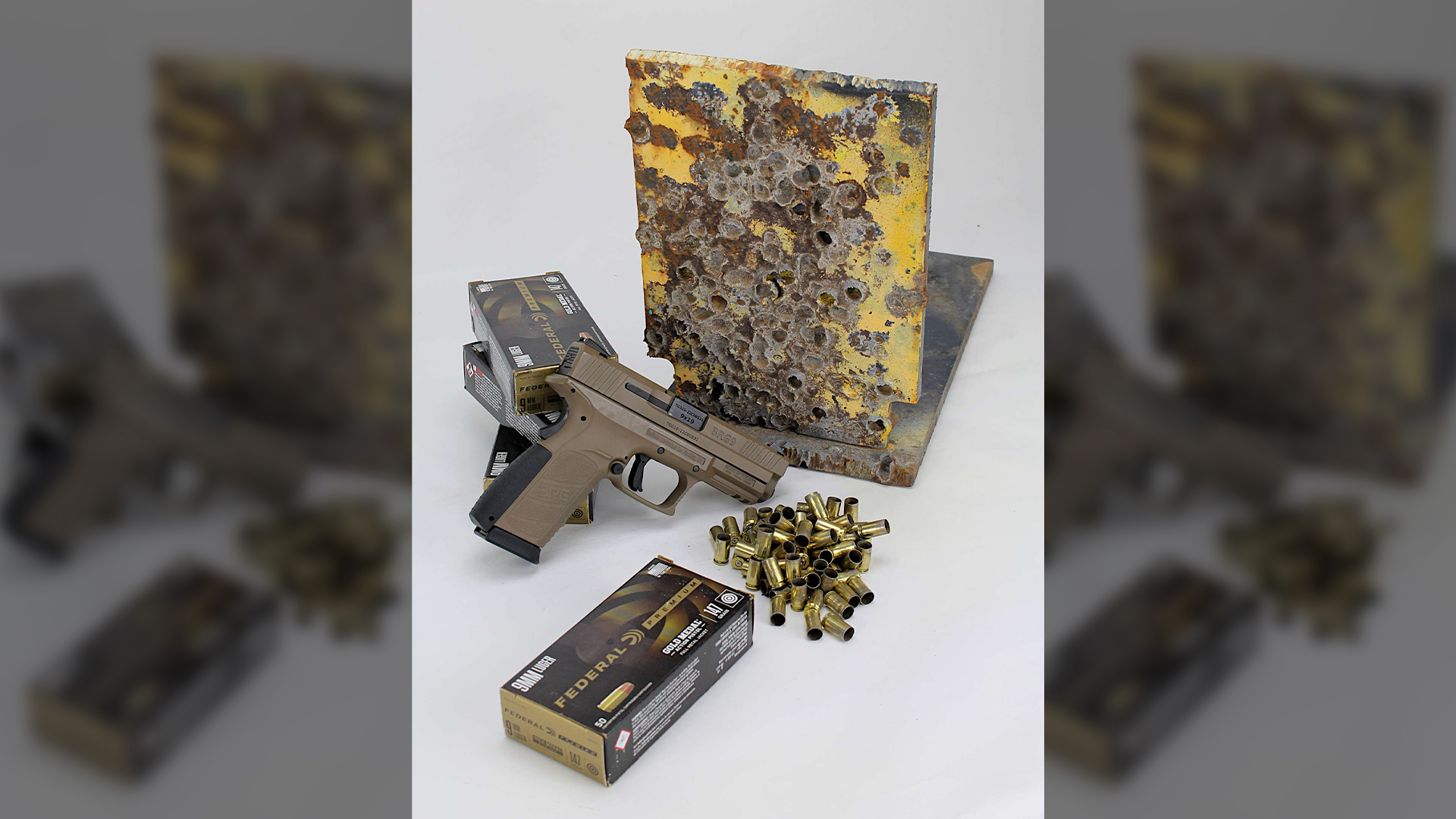
UNLEADED SHOOTING
A side benefit for indoor shooting, Federal’s Gold Medal Action Pistol primers are lead-free and, unlike standard full-metal jacket bullets with exposed lead bases, Gold Medal Action Pistol bullets are totally surrounded by jacket material (sometimes referred to as a total-metal jacket, or TMJ). This combination means that shooters aren’t exposed to airborne lead. Curiously, Federal’s lead bullet base appears to be covered with a separate copper disc swaged into place, rather than presenting a contiguous jacket.
CHRONOGRAPH RESULTS
Chronograph results are from three 10-shot strings of Federal Premium Gold Medal Action Pistol 147-grain 9 mm cartridges.

Federal’s MSRP for a 50-round box of 9 mm Gold Medal Action Pistol ammunition is $30.99 (price as of December 2023), while the .40 S&W 180-grain version is a bit more at $42.99 per box. For premium competition ammo, that’s a good deal. For more information, visit the Federal website.



























